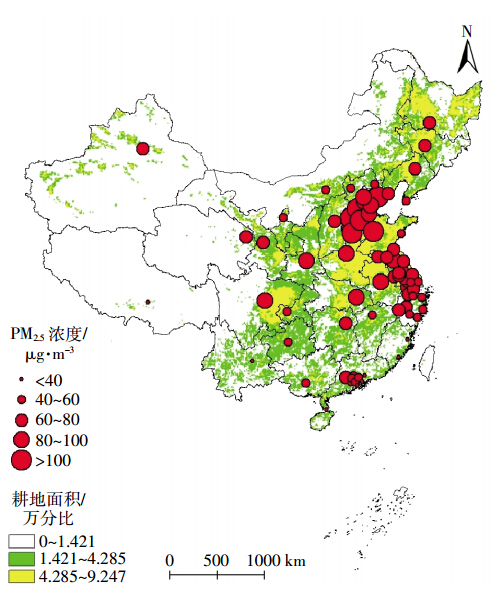文章信息
- 潘月鹏, 贾琳, 田世丽, 谢雨竹, 张国忠, 马红媛, 王丽丽, 于永强, 宋涛, 孙扬
- 大气霾污染对农业生产的可能影响
- Potential Effects of Haze Pollution on Agriculture in China
- 农业环境科学学报, 2014, 33(11): 2279-2280
- Journal of Agro-Environment Science, 2014, 33(11): 2279-2280
- http://dx.doi.org/10.11654/jaes.2014.11.030
-
文章历史
- 收稿日期:2014-7-9

2. 中国环境科学研究院环境标准研究所, 北京 100012;
3. 成都信息工程学院, 成都 610225;
4. 甘肃农业大学, 兰州 730070;
5. 中国科学院东北地理与农业生态研究所, 长春 130102
随着国民经济的快速发展,以煤炭为主的能源消耗量大幅攀升,机动车保有量急剧增加,由此引发的大气污染已成为制约我国社会可持续发展的瓶颈,特别是近年来频繁发生的区域性霾污染引起了公众和政府的广泛关注。当前,霾污染对能见度、空气质量和人体健康影响的报道较多,针对霾污染对农业环境影响的研究亟待开展。霾是气溶胶(颗粒物)本身的物理特征和化学成分消光引起的大气能见度下降,主要是人类活动加剧引起的细颗粒物(PM2.5)污染。因此,认知PM2.5的时空分布及其化学组成是评估霾污染影响的科学基础。环保部监测结果显示,我国大气PM2.5浓度呈现区域性污染特征,在京津冀、长三角、珠三角和成渝等地区成片分布。从空间分布上,PM2.5污染的高值区又与我国农业耕作区域重叠(图 1),这给农业生产如何应对日趋严重的霾污染提出了严峻挑战。

|
| 图 1 我国农业耕作区及PM2.5浓度分布 Figure 1 Spatial distribution of agricultural areas and PM2.5 concentration |
气溶胶是大气中自然存在的物质,其含量上升可削弱到达地面的太阳总辐射,进而影响植物光合作用和相关蛋白质的表达过程[1]。由于气溶胶含量上升及雾霾日数增多,20世纪最后40年到达我国地表的太阳辐射以每年2.54%的速度下降[2]。辐射降低已导致长三角冬小麦和水稻减产5%~30%[3]。在农作物生长季,辐射减弱效应随着多云天数的增加而增强,其对玉米、小麦和水稻产量的影响分别为-10%、±5%和±10%[4]。高浓度的气溶胶亦可增加散射辐射,特别是漫射光可从四面八方到达植物冠层,比太阳光束直接照射叶片更均匀,因而也能在一定程度上促进植物的光化学作用,这已被美国的外场观测资料所证实[5]。然而,霾污染如何通过改变太阳辐射影响农作物的品质和产量尚未有系统性研究。
霾污染还可能通过改变水热条件影响农作物的产量和品质,特别是气溶胶对太阳短波辐射的吸收以及对地气系统长波辐射的散射和吸收会造成昼夜温差缩小[6],进而削减植物白天光合作用的积累,增强夜晚呼吸作用的消耗,不利于作物体内有机物的积累。比如在平均温度17 ℃时,4 ℃昼夜温差与9 ℃温差相比,番茄苗期物质积累和相对生长速率显著降低[7]。同时,长期的霾污染呈现降温效应。温度降低会使农作物到达一定积温所需的时间延长,从而通过延长生育期对作物产量产生积极影响[8]。然而,控温试验表明,粳稻品种的蛋白质含量会随温度降低而减少[9]。因此,不同品种的农作物如何响应霾污染的定量评估亟待开展。
霾污染期间的大气细颗粒物一般呈酸性,沉降到植物表面可直接损伤叶表,也可堵塞叶片气孔,干扰光合、蒸腾和呼吸作用的正常进行[10]。此外,细颗粒物携带的有害物质(如持久性有机物和重金属)被植物吸收后会影响叶片蛋白质含量[11],降低叶绿素浓度活性及寿命[12],进而影响农作物产量及品质。细颗粒物中的有害成分通过扩散和沉降输入到土壤后也可以被作物吸收进而对其产生重要影响。比如,土壤镉累积4~5 mg kg-1时, 大豆和菠菜产量会下降25%[13]。重金属进入土壤后还可能改变根细胞膜渗透能力[14],影响植物正常的新陈代谢;在植物内的积累会影响细胞内离子平衡,抑制植物营养运输过程[15]。
霾污染发生时大范围天气条件趋于静稳,大气中常富集高浓度的NH3、NO2、O3和SO2等前体物。O3和SO2浓度增加对农作物产量的影响已是不争的事实,但上述前体物与霾污染并存对农业生产的协同影响尚不清楚。霾污染频繁发生的冬季往往伴随着低温和高湿度,这些环境因子叠加在一起是否会加速病虫害流行(如“气象型”赤霉病)也应给予关注。虽然我国正在采取一系列措施降低污染物的排放,但有效缓解霾污染仍需几十年的时间。在相当长的时期内,霾污染都可能通过改变太阳辐射和水热条件,以及输入有毒有害物质对农作物产量和品质产生重要影响。霾污染与温室气体和酸沉降等其他环境压力并存,将成为未来农业生产面临的严峻挑战。
| [1] | Yan X, Shi W Z, Zhao W J, et al. Impact of aerosols and atmospheric particles on plant leaf proteins[J]. Atmospheric Environment, 2014, 88: 115-122. |
| [2] | Che H Z, Shi G Y, Zhang X Y, et al. Analysis of sky conditions using 40 year records of solar radiation data in China[J]. Theoretical and Applied Climatology, 2007, 89(1-2): 83-94. |
| [3] | Chameides W L, Yu H, Liu S C, et al. Case study of the effects of atmospheric aerosols and regional haze on agriculture: An opportunity to enhance crop yields in China through emission controls?[J]. Proceedings of the National Academy of Sciences of the United States of America, 1999, 96(24): 13626-13633. |
| [4] | Greenwald R, Bergin M H, Xu J, et al. The influence of aerosols on crop production: A study using the CERES crop model[J]. Agricultural Systems, 2006, 89(2-3): 390-413. |
| [5] | Gu L, Fuentes J D, Shugart H H, et al. Responses of net ecosystem exchanges of carbon dioxide to changes in cloudiness: Results from two North American deciduous forests[J]. Journal of Geophysical Research: Atmospheres(1984—2012), 1999, 104(D24): 31421-31434. |
| [6] | 张小曳. 中国大气气溶胶及其气候效应的研究[J]. 地球科学进展, 2007, 22(1): 12-16 ZHANG Xiao-ye. Aerosol over China and their climate effect[J]. Advances in Earth Science, 2007, 22(1): 12-16. |
| [7] | Gent M P. Carbohydrate level and growth of tomato plants I. The effect of carbon dioxide enrichment and diurnally fluctuating temperatures[J]. Plant physiology, 1984, 76(3): 694-699. |
| [8] | 王鹤龄. 增温和降水变化对半干旱区春小麦影响及作物布局对区域气候变化的响应研究 [D]. 兰州: 甘肃农业大学, 2013. WANG He-ling. Effects of warming and precipitation on spring wheat in the semi-arid region, and response of crop layout on regional climate change [D]. Lanzhou: Gansu Agricultural University, 2013. |
| [9] | Resurreccion A P, Hara T, Juliano B O, et al. Effect of temperature during ripening on grain quality of rice[J]. Soil Science and Plant Nutrition, 1977, 23(1): 109-112. |
| [10] | Terzaghi E, Wild E, Zacchello G, et al. Forest filter effect: Role of leaves in capturing/releasing air particulate matter and its associated PAHs[J]. Atmospheric Environment, 2013, 74: 378-384. |
| [11] | Hassan Z, Aarts M G. Opportunities and feasibilities for biotechnological improvement of Zn, Cd or Ni tolerance and accumulation in plants[J]. Environmental and Experimental Botany, 2011, 72(1): 53-63. |
| [12] | Manios T, Stentiford E I, Millner P A. The effect of heavy metals accumulation on the chlorophyll concentration of Typha latifolia plants, growing in a substrate containing sewage sludge compost and watered with metaliferus water[J]. Ecological Engineering, 2003, 20(1): 65-74. |
| [13] | 翟 薇, 赵艳霞, 王春乙,等. 大气气溶胶变化对农业影响的研究进展[J]. 气象科技, 2006, 34(6): 705-710. ZHAI Wei, ZHAO Yan-xia, WANG Chun-yi, et al. Advances in effect study of atmospheric aerosol changes on agriculture[J]. Meteorological Science and technolgy, 2006, 34(6): 705-710. |
| [14] | De Filippis L. The effect of heavy metal compounds on the permeability of Chlorella Cells[J]. Zeitschrift für Pflanzenphysiologie, 1979, 92(1): 39-49. |
| [15] | Ovecka M, Takác T. Managing heavy metal toxicity stress in plants: Biological and biotechnological tools[J]. Biotechnology advances, 2013, 32(1): 73-86. |
 2014, Vol. 33
2014, Vol. 33



